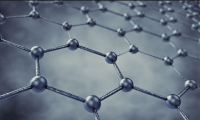








Graphene is an allotrope of carbon in the form of a two-dimensional, atomic-scale, hexagonal lattice in which one atom forms each vertex. It is the basic structural element of other allotropes, including graphite, charcoal, carbon nanotubes and fullerenes. It can also be considered as an indefinitely large aromatic molecule, the limiting case of the family of flat polycyclic aromatic hydrocarbons.
Early History
The creation of graphene, a wonder material that promises to transform the future, is already the stuff of scientific legend. As a piece of brilliant serendipity it stands alongside the accidental discovery of penicillin by Alexander Fleming – and it might prove just as valuable.
Two Russian-emigre scientists at the University of Manchester, Andrei Geim and Kostya Novoselov, were playing about with flakes of carbon graphite in an attempt to investigate its electrical properties when they decided to see if they could make thinner flakes with the help of sticky Scotch tape.
They used the tape to peel off a layer of graphite from its block and then repeatedly peeled off further layers from the original cleaved flake until they managed to get down to flakes that were only a few atoms thick. They soon realised that by repeatedly sticking and peeling back the Scotch tape they could get down to the thinnest of all possible layers, one atom thick – a material with unique and immensely interesting properties.
When the two scientists won their joint Nobel prize in physics in 2010 for their ground-breaking experiments, the Nobel committee made a point of citing the “playfulness” that was one of the hallmarks of the way they have worked together.
Playing about with Scotch tape on a Friday afternoon sounds a jokey thing to do, but it soon turned into a deadly serious game of scientific discovery which would have been impossible if not for the well-prepared minds of Geim and Novoselov.
“A playful idea is perfect to start things but then you need a really good scientific intuition that your playful experiment will lead to something, or it will stay as a joke for ever,” Novoselov says. “Joking for a week or two is the right way to go, but you don’t want to make your whole research into a joke.”
Geim, who is 15 years older than Novoselov and was once his PhD supervisor, has a reputation for playful experiments. He levitated a frog in 1997 to showcase his work in magnetism and invented a new kind of sticky tape based on the adhesive feet of Gecko lizards, which can walk up walls and hang upside down on ceilings.
The original idea of working with graphite was to see if it could be used as a transistor – the fundamental switching device at the heart of computing. In fact, Novoselov says, they had almost given up with graphite when they heard about how microscopy researchers working along the university corridor used Scotch tape to clean the mineral before putting it under the lens.
“It was not a new technique, and I’d heard of it before, but when you see it in front of you it makes it obvious what it can be used for,” Novoselov recalls.
Graphene, a two-dimensional crystal of pure carbon, is a superlative material. It is the thinnest and strongest substance known to science – about 100 times stronger than steel by weight. A square metre of graphene, a thousand times thinner than paper, made into a hammock would be strong enough to cradle a 4kg cat, but weigh no more than one of its whiskers. It is a good conductor of electricity, is stretchable and yet is almost transparent. It conducts heat better than any other known substance. It acts as a barrier to the smallest atom of gas – helium – and yet allows water vapour to pass through.
This particular property has allowed the two Russians to perform another playful experiment, this time in passive vodka distillation – water evaporates through a graphene membrane placed over a mug of watered-down vodka, leaving the concentrated alcohol behind.
The inventive step that made Geim and Novoselov into Nobel laureates was to find a way of transferring the ultra-thin flakes of graphene from Scotch tape to a silicon wafer, the material of microprocessors. Once they did this the extraordinary electrical properties of graphene could be witnessed and explored, including its “ghostly” quantum state when electrons start to behave weirdly as if these particles have no mass. “The excitement would exist even without these unusual properties because graphene is the first two-dimensional material. It seems obvious now because we can suspend it in the air and do almost anything with it, but at the beginning it was by no means obvious that it would be stable,” Novoselov says.
Uses
The potential uses for graphene appear almost limitless. They range from new types of flexible electronics that could be worn on clothes or folded up into a pocket, to a new generation of very small computers, hyper-efficient solar panels and super-fast mobile phones. Yet at the heart of graphene is a honeycomb structure of carbon atoms – described as “atomic chickenwire”. Carbon is the basic element of life, which means that graphene could be the focus of a new industrial revolution based on electronic components that are biodegradable and sustainable. If there was ever a building material for a new, green economy, graphene could be it. As a result, the Government has actively supported a new National Graphene Institute (NGI) in Manchester, which will be completed by 2015 at the cost of £61m, of which £38m is coming from government research councils.